Column-Level Lineage: Bringing Clarity and Confidence to Migration
Column-level lineage provides a detailed view of how data flows across every column within tables, transformations, and reports. Unlike traditional dataset- or table-level lineage, column-level lineage traces dependencies and transformations at the most granular level, enabling enterprises to understand exactly where each piece of data originates, how it changes along the way, and where it is ultimately consumed. This transparency is vital during complex modernization initiatives, as it ensures accuracy, consistency, and accountability when transitioning from legacy systems to modern, cloud-native environments.
By leveraging LeapLogic’s advanced column-level lineage, organizations gain a precise map of data movements, correlations, and dependencies across diverse technologies. This feature not only accelerates migration planning but also reduces risk by uncovering hidden dependencies, redundant logic, and unused attributes. It enables business and technical stakeholders alike to validate that critical information is preserved, compliance requirements are met, and downstream analytics remain accurate post-migration.
For customers embarking on large-scale modernization journeys, column-level lineage offers a strategic advantage. It empowers data architects to plan migrations with confidence, minimizes business disruption, and supports governance initiatives by ensuring end-to-end traceability. Ultimately, this level of detail turns migration into a more predictable, transparent, and value-driven process—helping enterprises unlock the full power of their new cloud-native architecture without losing trust in their data.
Let’s see how you can efficiently search the required end-to-end dependency structure.

To view the required column-level lineage:
- Select the Data tab to enable data lineage.
- Enter the Column Names or Table Names in the Search Keywords field you want to search. Else, simply select the columns or tables from the Search dropdown.
- Turn on Include Columns toggle to render columns and their lineage on the UI.

- Click the Search icon to generate the lineage.

Column-level Lineage – Effective Migration Roadmaps
Column-Level lineage shows granular transformations and updates at the minutest level, providing complete visibility into the data flows. This capability powers effective migration roadmaps by offering:
- Granular visibility into relationships – Traces column-to-column relationships across tables, transformations, and reports, giving a crystal-clear understanding of how data elements are connected.
- Hierarchical depth to the nth level – Expands columns within tables and uncovers lineage across multiple layers, ensuring even the most deeply nested dependencies are visible.
- Advanced search and navigation – Enables users to quickly locate specific columns, explore their lineage paths, and analyze directional data flows for precise planning.
- Dependency directionality – Shows whether a column is a source, intermediate transformation, or downstream consumer, helping to prioritize critical paths for migration.
- Supports phased migration – Identifies isolated or loosely coupled components first, allowing teams to break down large workloads into manageable, low-risk phases.
- Risk mitigation – Detects redundant, unused, or orphaned attributes, ensuring only necessary, business-critical columns are migrated.
- Groundbreaking lineage intelligence – Combines deep column expansion, nth-level traceability, and intuitive visualization to deliver a level of transparency rarely available in legacy-to-cloud migration tools.
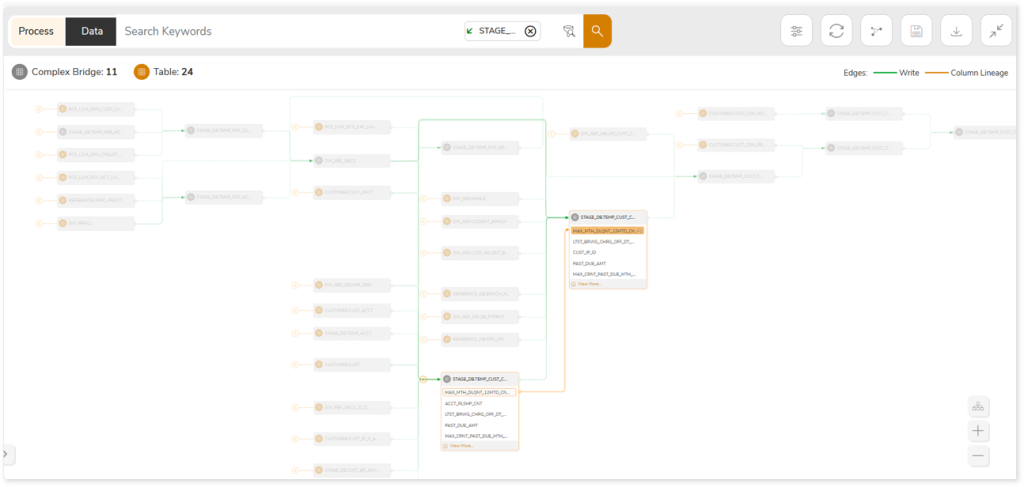
In addition, the filter search icon allows you to include or exclude particular nodes to obtain the required dependency structure. It helps you quickly narrow down complex dependency graphs to focus on the exact nodes, relationships, or data flows you want to analyze. Instead of navigating through an entire lineage network, you can apply filters based on object names, types, or relationship categories—making it easier to isolate specific tables, columns, workflows, or transformation paths. This feature enhances traceability, reduces visual clutter, and enables you to precisely identify upstream or downstream dependencies that are most relevant to your analysis or migration scope.
You can also choose the direction of the lineage. By default, the Dependency Direction is Left to Right Hierarchy. This insight is useful to identify and analyze upstream data connections and relationships. You can also choose Right to Left Hierarchy – most useful for how data is getting consumed through the downstream route and which are the participating tables and columns, or Bidirectional dependency direction to visualize both kinds in a single view.
Moreover, you can also increase the Hierarchy Levels to nth level. This again allows great freedom to visualize the end-to-end hierarchy in one go.
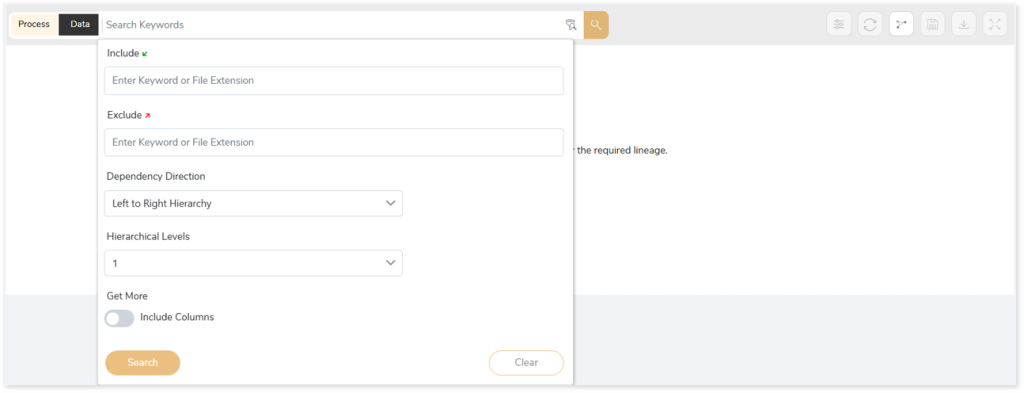
Lineage facilitates you visualize how your selected nodes are connected and depend on each other. The nodes and their connecting edges (relationships) help you to understand the overall structure and dependencies.
|
Nodes |
Edges |
 Tables Tables |
 Call Call |
 File File |
 Read Read |
 Job Job |
 Execute Execute |
 Autosys Box Autosys Box |
 Write Write |
 Workflows Workflows |
 Others Others |
 Flat File Flat File |
|
 DB Type DB Type |
|
To enhance your interaction with the lineage graph, you can apply the following features.
| Feature | Icon | Use |
| Filter |  | Used to filter the lineage. |
| Reload Graph |  | Assists in reloading graphs. |
| Manage Graph |  | To view and manage lineage by adding, modifying, or deleting nodes and their relationships to accurately reflect dependency structures. |
| Save |  | Used to save the lineage. |
| Download |  | Used to download the file. |
| Expand |  | Used to enlarge the screen. |
To learn more about managing lineage, including how to add, modify, or delete nodes and their relationships, click here.
Downloadable Reports
Downloadable lineage reports offer a consolidated view of process, data, and column-level dependencies, enabling you to review and analyze the lineage information.
Here, taking Informatica as an example, the downloaded report includes the following lineage reports:
- assessment_column_lineage.csv: This report provides information about workflow-level column lineage. It includes information about source and target nodes (tables or files) along with associated columns, types, and more.
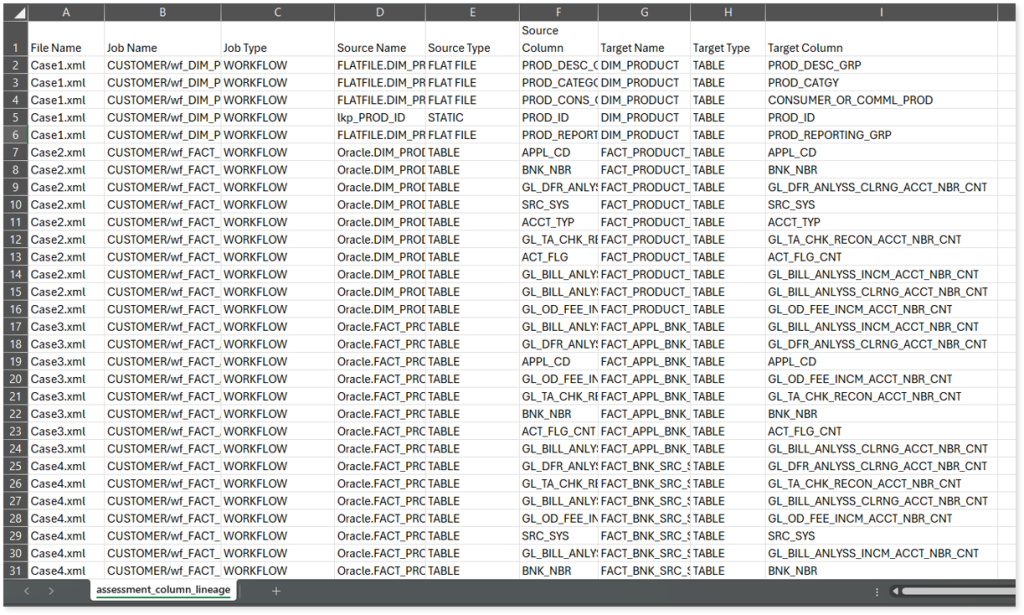
- informatica_dataLineage.csv: This report provides information about entity or file level lineage based on write operation.

- mapping_column_lineage.csv: This report provides information about mapping-level column lineage. It includes information about source and target nodes along with associated columns, types, database types, and more.
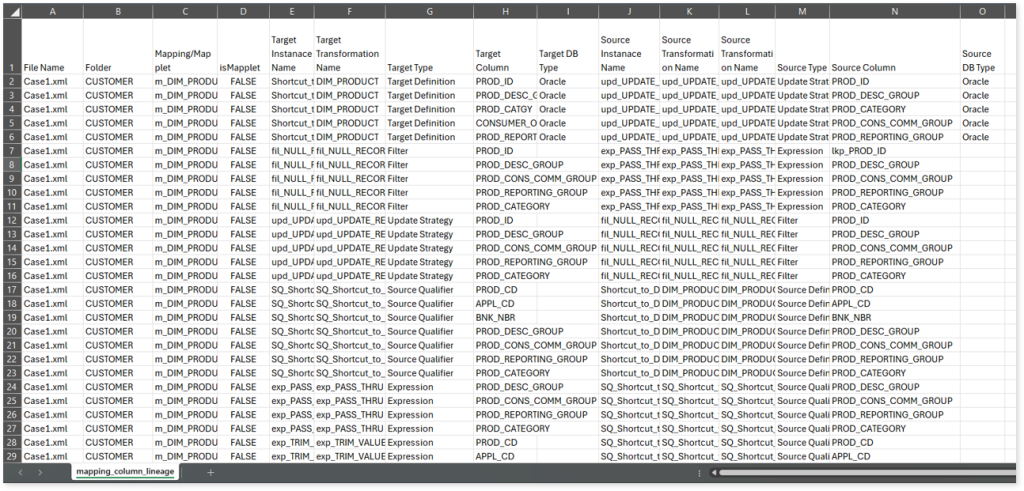
- Lineage Report: This report provides complete dependency details for all nodes. It provides an end-to-end data and process lineage that helps to identify the complete dependency structure and the data flow.
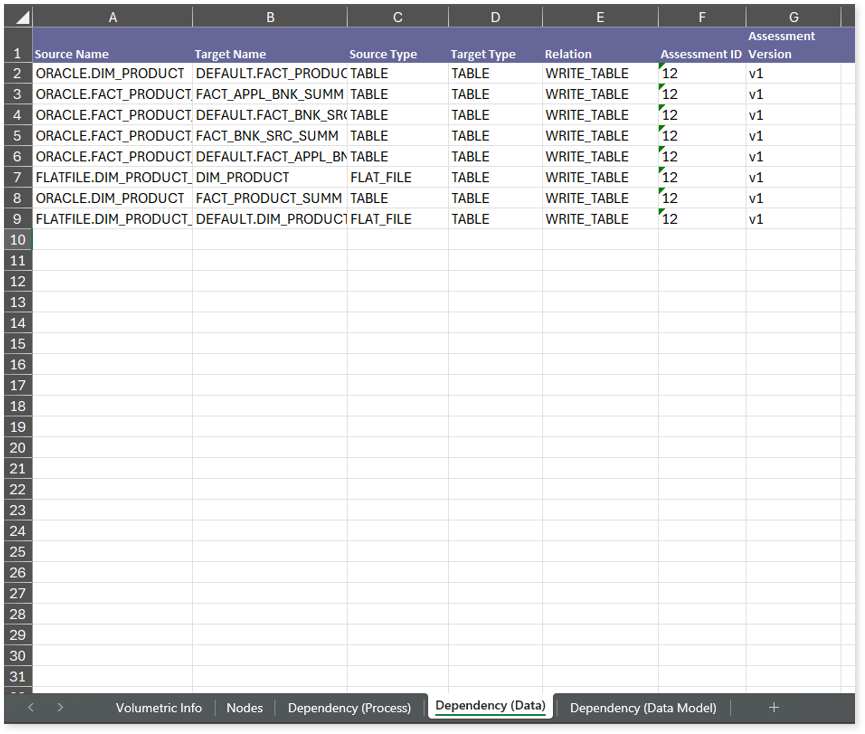
This report contains the following information:
- Volumetric Info: Provides volumetric information about the artifact types including tables, database types, workflows, flat files, and scheduler jobs.
- Nodes: Lists all the source and target nodes along with their type. Each node represents a data object in the lineage—such as a table, file, job, etc.—making it easier to trace how data is consumed, transformed, and processed across the workflow.
- Dependency (Process): Provides information about the process lineage. It offers detailed visibility into interdependencies between processes—such as files, workflows, and orchestration steps—helping you understand how they are connected within the workflow.
- Dependency (Data): Provides information about the data lineage. It captures detailed table-level and column-level dependencies—including input tables, output tables, and reference tables—offering end-to-end visibility into how data flows and transforms across the workflow.
- Dependency (Data Model): Provides information about the data model lineage. It highlights the end-to-end relationships and dependencies between model elements, helping users understand structure and trace linkages.
In summary, column-level lineage is more than just a technical feature—it is a strategic enabler for risk-free modernization. By providing unmatched visibility into column-level flows, transformations, and relationships, LeapLogic ensures that enterprises can confidently plan, validate, and execute migrations from legacy ecosystems to cloud-native platforms. This level of insight not only safeguards business-critical information but also accelerates the path to modernization by fostering trust, compliance, and operational efficiency. With column-level lineage, organizations can embrace the cloud future with clarity, control, and confidence.
To explore the Data and Process lineage, click here.